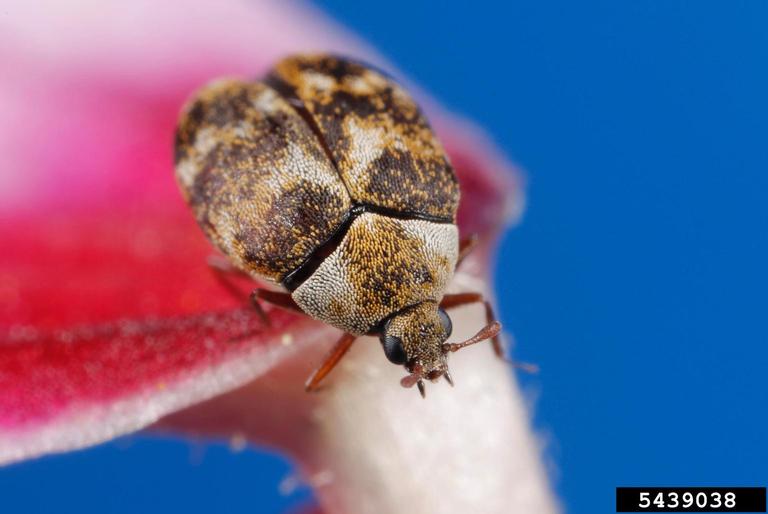What are carpet beetles (and what should you do about them)

Is there’s a small bug with black, brown and perhaps white zigzag stripes on its back or perhaps one with a single, wide strip on it’s back on your rug? Or maybe some small creepy-crawly looking brown fuzzy worm-like critters in your pantry? What is it?
Meet your houseguests of the family Dermestidae.
Anyplace humans call home is the perfect habitat for any of the several varieties of insects in the scientific order Coleoptera, more commonly known as larder or carpet beetles. Ranging in size from 1mm to 12mm, these tiny beetles also go by the name skin beetle, hide beetle or leather beetle.
All of these common names represent what the family of Dermestidae prefer to munch on: household items like the feathers in down pillows, fabric, woolen items, dog hair, cat hair, animal dander, dried fruit, flour, nuts and pasta.
“They are a scavenger,” according to Clay Kirby, insect diagnostician with the University of Maine Cooperative Extension. “They will get into your stored food products, furniture or clothing and that can make them difficult to manage.”
The 500 or so species in the family Dermestidae also feed on dead insects.
“So if you have dead cluster flies in your attic or wall voids, you may have carpet beetles feeding on those carcases,” Kirby said.
Dermestidae are at their most destructive — from the human point of view — in their larval stage, according to Kirby.
What do carpet beetles eat?
The larvae are often brown, less than a quarter-inch long and appear furry.
“The adult [dermestidae] stage is most interested in feeding outside on pollen or nectar,” Kirby said. “It’s the wormlike larval stage that does the damage in the home.”
Often when people pull seasonal woolen or fur trimmed clothing out of storage and spot holes, they blame common clothes moths [Tineola bisselliella] but Kirby said they are often falsely accused.
“Everyone blames the clothes moths when they pull something out of the cedar trunk and find holes in it,” Kirby said. “But the carpet beetle should really be on the suspect list.”
The key to keeping carpet beetle larvae out of the house, Kirby said, is denying them their favorite food.
“Pantry items like flour, Bisquick, pasta, nuts, cereals or dried fruits should be kept in tight sealing containers like glass or rubber,” he said. “The same thing with your seldom worn clothing items that have fur, feathers or are made of wool — keep them in sealed plastic bags or containers.”
Keep vigilant, Kirby said, and inspect fabrics and even taxidermied animals for holes or fraying that could be caused by the beetles.
How to get rid of carpet beetles
If you find evidence of carpet beetles in your house, the best way to get rid of them is vacuuming the area where you say them and then steam cleaning the same area.
Several online sites devoted to pest removal, including The Bugman, a pest control company in the Pacific Northwest, also suggest washing contaminated fabric or pillows in hot water and detergent and wiping down any surfaces where you suspect carpet beetles to be hanging out with pure vinegar.
Sprinkling boric acid on carpets, rugs or furniture will also kill remaining beetles. Leave the boric acid dust untouched for two hours after sprinkling it and then vacuum it up. Immediately dispose of that vacuum bag.
“They are not dangerous to people,” Kirby said. “But your heart does kind of sink when you find evidence of them.”
